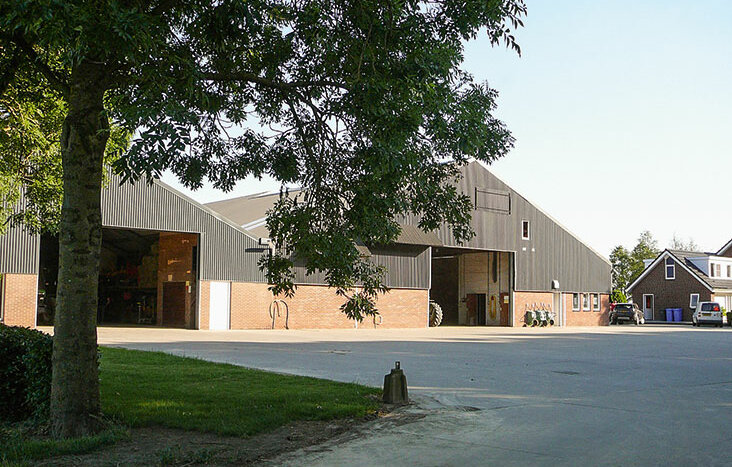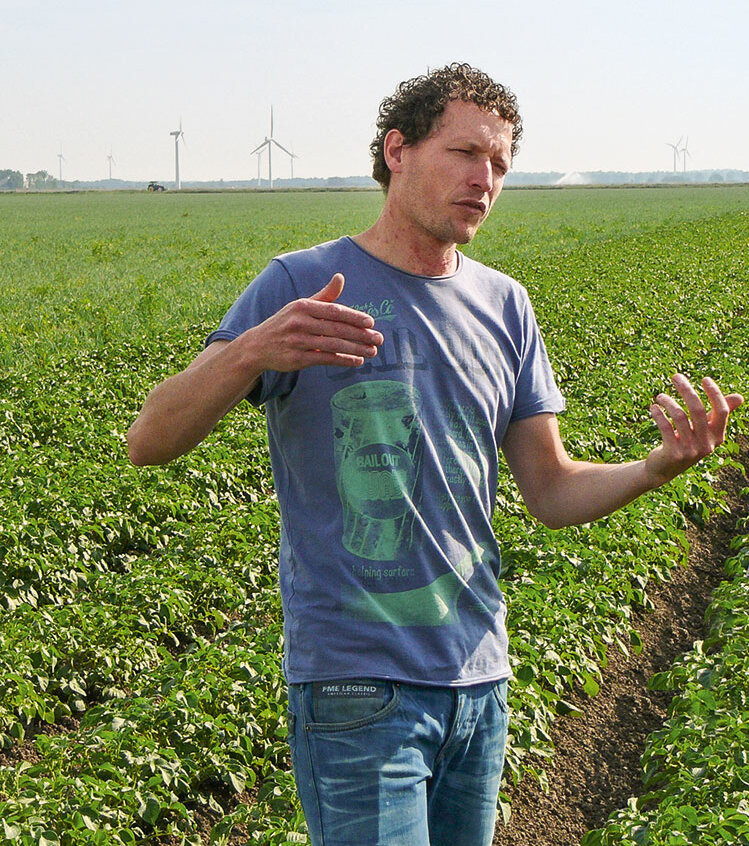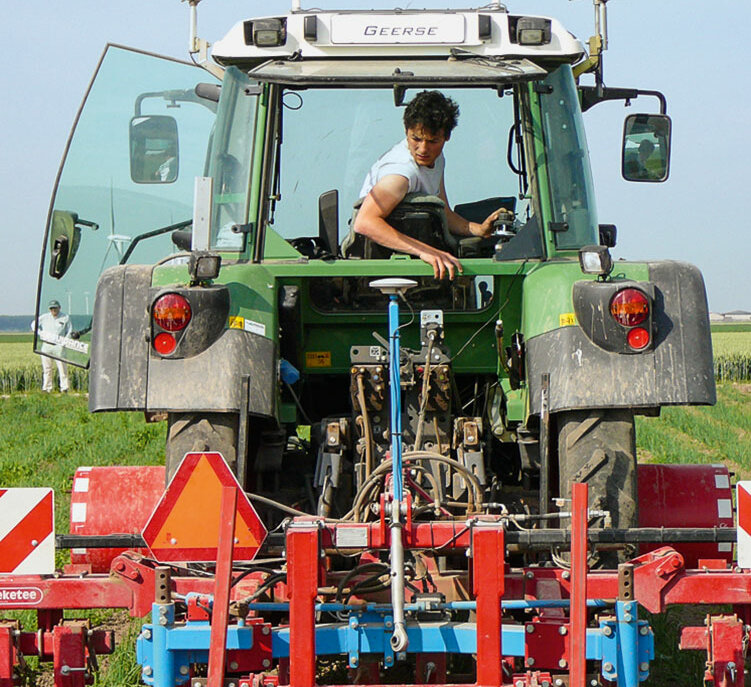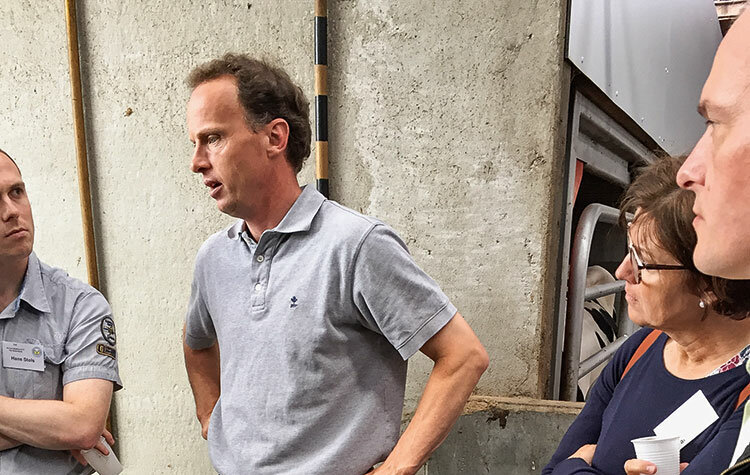Polder pioneers
by Thomas Preuße
The Netherlands. The efforts involved in wresting polder land from nature have been huge. And because polder soil is fertile, scarce and therefore expensive, it’s intensively farmed. Here, we present three outstanding farming businesses in the northeastern polder and Flevopolder.
Leo de Jonge and his wife Wilhelmina Verbeek produce crops, and lately started to run a dairy herd, on two units. Thijs Geerse produces organic crops in close cooperation with neighbour Wouter Snippe. Erik Damann advises farming businesses on financial matters and manages »on the side« a large dairy farm with his brother Jan-Hendrik.
Leo de Jonge, Zeewolde
60 ha: back in 1980 this was the standard size of farm in the newly drained Flevopolder as Leo de Jonge’s parents sold their farm in the northern province of Groningen and began anew with a 40-year tenancy. The rotation of 15 ha potatoes, 15 ha sugar beet, 25 ha wheat and 5 ha onions stayed much the same until junior took over in 1997. »With the time limitations of the tenancy agreement, it was difficult in the long-term to get loans from the bank«, recalls Leo de Jonge. »However, at that time the state as landowner introduced a buying programme at favourable conditions and I was able to purchase half the farm area. Afterwards, sinking interest rates and rising land prices meant further developing the farming business was easier«.
Buying means a firm hold on farmland
In 2004, a second farm about 20 km away was added: 6 ha bought and 51 ha under a 10-year tenancy agreement. While the contract had an extension clause, there was no agreed rent for the prolongation. Later came the opportunity to purchase this rented land from the government as well as the 31 ha still rented on the first farm. »We weren’t happy about this. But if we hadn’t bought, someone else would have. So, after many discussions we ended up owning 119 ha – and a pile of debt«.
From then on, as little as possible was invested. But as early as 2011 the de Jongs found themselves able to build a new storage barn for onions. Nor did they miss the chance of purchasing a neighbouring 35 ha in 2015. By end of 2017 a further 18 ha were bought along with a barn for 85 dairy cows with an employed herd manager. Leo de Jong had worked in cooperation with this farm for a long time before purchase; pasture in the rotation and dung being important factors in his farming. »With that deal completed, we’ve stopped for the moment. But in ten years, we might think about taking further steps. Then, it will also be clearer if one of our four children wants to take over the business«.
Cooperation is necessary
The current rotation runs from potatoes and sugar beet over onions and wheat to tulips and willow tree growing. There’s multiple cooperation with seven neighbours: exchange of land (so that healthy rotations can be maintained), the sharing of slurry and of contracted work. In total, the de Jongs cultivate 259 ha with an average field size of 11 ha, of which 163 ha are owned. Potatoes are the most important crop (76 ha ware and 6 ha seed for own use), followed by sugar beet, onions and wheat.
The more exotic crops such as tulip bulbs and the tree nursery are run by neighbours on the de Jong land to maintain rotations. Except for the beet harvest, the irrigation work and slurry spreading, this farming business owns all required machinery with necessary crop storage onfarm.
Leo de Jong also remains as independent as possible in marketing, despite the high financial risks involved in owner occupation. »When you contract too much, you miss out on taking peak profits. A good mixture is what counts«.
Sourcing natural manure
Both farms work together with nearby milk producers who deliver slurry and offer the extra land needed to help with rotations. Crop nutrition in organic farms without livestock is a challenge, even when the regulations stipulate that only 65% of nitrogen has to come from organic sources. »Our next theme is perhaps the microbiological risks with slurry«. They mean the potential of disease spread through this medium. With the increasing movement towards organic production in dairying, though, availability of organic slurry will improve. Additionally, both farmers apply as crop nutrition solid farmyard manure, compost and by-products from potato starch production.
Last year the Geerse-Snippe cooperation invested in a packaging plant for potatoes and onions. There’s a trend towards shortening the supply chain, especially for organic products. More and more supermarkets buy directly from farmers. The only stumbling block here for the farmers can be the right to use certain variety names which are the property of the respective breeders.
Selling from the farm is strengthened in Flevoland for the 1300 members of the Agrico cooperative which applies pool marketing. Hereby, though, the price isn’t completely settled until the following June. Geerse and Snippe plan direct deliveries to the Tesco chain with new varieties.
Organic growing presents both farmers with high risks, but also attractive opportunities. The chance lies in the annual market growth of 10%, they say. The risks include »overnight« outlisting by supermarkets if, for example, organic onions become too expensive. Naturally, the two-year transitional period is also a challenge.
»There are those who simply sow lucerne on the transition areas over that period and themselves find work elsewhere«. These Dutch farmers are certainly flexible!
Erik and Jan-Hendrik Damman, Nagele
Actually, dairy farming is a superior kind of »hobby« for Erik Damman. Most of the working week this 44-year-old spends as financial advisor for other farmers. After all, there’s his brother Jan-Hendrik plus three full-time workers and six milk robots to look after the current herd of 385 dairy cows.
If there’s a format in the management of this farm, which has existed here since 1994, then it features maximum flexibility and simplicity in the daily work, summarised in the motto: one shouldn’t be running after the cows all day long. After all, smiles Erik Damman, the cows already stroll on their own to the robot milkers three times daily.
A typical tale of expansion
Starting with 70 cows and 45 ha 20 years ago, new buildings were erected in 2009 and 2014. With 9300 l/cow and year, performance is impressive. The cows manage five lactations compared with the Dutch average of 3.8. On the 165 owned hectares and 200 ha tenanted land, one third is down to grass with the remainder divided between tulips, sugar beet, onions and seed potatoes. The Dammans need land from neighbours for the seed potato rotation and in return they grow maize and grass for them. »Crop growing is really much better than dairying«, jokes Damman. »The work is easier and there’s more to be earned«.
A challenge: making money with dairy cattle
70 % of farms milking cows, reckons Erik Damman looking to his advisory experience, have financial problems. However, his own situation tends to be less troubled in this respect in that the family have more than enough land so that, in 2017, cows had not to be sold off as a result of the tightened phosphate emission regulations. Naturally through, the calf prices slumped. The feeding technique is simple: only 30% maize and 70% grass as forage and no beet pulp or similar additions. With reasonable effort and still high milk yields, even the deep milk price dives can be better survived.








